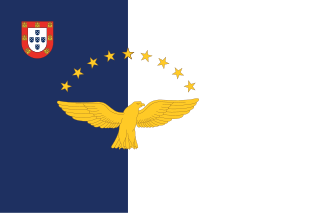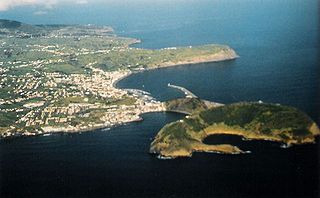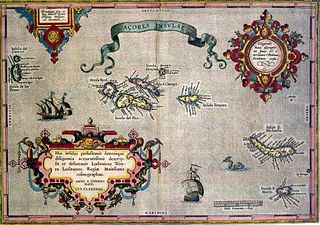Related Research Articles

The Azores, officially the Autonomous Region of the Azores, is one of the two autonomous regions of Portugal. It is an archipelago composed of nine volcanic islands in the Macaronesia region of the North Atlantic Ocean, about 1,400 km (870 mi) west of Lisbon, about 1,500 km (930 mi) northwest of Morocco, and about 1,930 km (1,200 mi) southeast of Newfoundland, Canada.

Dom Henrique of Portugal, Duke of Viseu, better known as Prince Henry the Navigator, was a central figure in the early days of the Portuguese Empire and in the 15th-century European maritime discoveries and maritime expansion. Through his administrative direction, he is regarded as the main initiator of what would be known as the Age of Discovery. Henry was the fourth child of King John I of Portugal, who founded the House of Aviz.

Corvo Island, literally the Island of the Crow, is the smallest and the northernmost island of the Azores archipelago and the northernmost in Macaronesia. It has a population of approximately 384 inhabitants making it the smallest single municipality in the Azores and in Portugal. The island lies on the North American Plate.

Flores Island is an island of the Western Group of the Azores.

Vila do Corvo is the smallest municipality in the Portuguese archipelago of the Azores, constituting the island of Corvo in its entirety. With a population of 430 in 2011, it is the least populated of the Portuguese municipalities, and the only Portuguese municipality, by law, without a civil parish. Its area is 17.11 square kilometres (6.61 sq mi).

Santa Cruz das Flores is a municipality situated in the north half of the island of Flores, in the Portuguese archipelago of the Azores. Situated in the sparsely populated Western Group, the population in 2021 was 2,020 inhabitants in an area that covers approximately 70.91 square kilometres (27.38 sq mi), bordering the southern municipality of Lajes das Flores.

Ponta Delgada is a rural civil parish in the Azorean municipality of Santa Cruz das Flores, on the Portuguese island of Flores. The population in 2021 was 280, in an area of 17.65 km2. It is situated along the northern coast from the regional capital. It is the third oldest religious parish on the island of Flores, only preceded by the communities of Lajes and Santa Cruz das Flores.

Faial Island, also known in English as Fayal, is a Portuguese island of the Central Group of the Azores, in the Atlantic Ocean.

Praia do Almoxarife is a freguesia in the municipality (concelho) of Horta, of the Portuguese archipelago of the Azores. The population in 2011 was 834, in an area of 9.20 km2. Although it was the beachhead of early settlement on the island, its population has not grown significantly since it was settled. It has become an important summer destination and tourist center for its long black sand beach.

Santa Maria is an island in the eastern group of the Azores archipelago and the southernmost island in the Azores. The island is known for its white sand beaches, distinctive chimneys, and dry warm weather.
Johan Frans Podolyn or Johann Franz Podolyn was a Swedish numismatist who published on Punic currency in his possession which had been found on the island of Corvo in the Azores. He wrote about the discovery in 1778 in a Swedish academic publication now known as the Publications of the Royal Society of Sciences and Letters in Gothenburg, presumably indicating that he was a member of the society.

The District of Horta was a district of the Ilhas Adjacentes, consisting of the dependent western islands of the Azores, located in the Atlantic Ocean. The district of Horta, not to be confused with the modern municipality of Horta, existed from 1836 until 1976 when it was abolished in favour of the autonomy charter of the 1975 Portuguese Constitution.

Madre de Deus was a Portuguese ocean-going carrack, renowned for her capacious cargo and provisions for long voyages. She was returning from her second voyage East under Captain Fernão de Mendonça Furtado when she was captured by the English during the Battle of Flores in 1592 during the Anglo–Spanish War. Her subsequent capture stoked the English appetite for trade with the Far East, then a Portuguese monopoly.

The following article describes the history of the Azores, an archipelago composed of nine volcanic islands in the Macaronesia region of the North Atlantic Ocean, about 1,400 km (870 mi) west of Lisbon, about 1,500 km (930 mi) northwest of Morocco, and about 1,930 km (1,200 mi) southeast of Newfoundland, Canada.
Father José António Camões was a Portuguese Catholic priest, poet and historian. He wrote several works of satire, including his heroic satire O Testamento de D. Burro, Pai dos Asnos.
Diogo de Teive was a maritime captain and squire to the House of Infante D. Henrique (1394-1460) during the Portuguese period of discovery. Following his exploration into the western Atlantic in the area of Newfoundland, in 1452 he discovered the western islands of the archipelago of the Azores: for his efforts he was appointed Donatary for the islands of Flores and Corvo.

Monchique Islet is a small uninhabited islet off the coast of the island of Flores, west of the village of Fajã Grande, in the western part of the Portuguese archipelago of the Azores. It is the westernmost point of Portugal and, if considered part of Europe, is Europe's westernmost point as well.
Gabriel de Vallseca, also referred to as Gabriel de Valseca and Gabriel de Valsequa was a cartographer of Jewish descent connected to the Majorcan cartographic school. His most notable map is the portolan of 1439, containing the first depiction of the recently-discovered Azores islands.

The Battle of Flores (1592), also known as Cruising Voyage to the Azores of 1592, or the Capture of the Madre de Deus describes a series of naval engagements that took place from 20 May to 19 August 1592, during the Anglo-Spanish War. The battle was part of an expedition by an English fleet initially led by Sir Walter Raleigh, and then by Martin Frobisher and John Burgh. The expedition involved the capture of a number of Portuguese and Spanish ships including the large Portuguese carrack Madre de Deus, after a long naval battle off the island of Flores in the Azores. The expedition, particularly the capture of the great carrack, was a financial and military success. The rich cargo aboard the carrack, which at the time equaled nearly half the size of the Kingdom of England's royal annual revenue, was subject to mass theft when it arrived in Dartmouth, England, followed by quarrels over the shares of the prize. The expedition had formative consequences for the English both financially and on the future of English exploration.
The statue of Corvo was an equestrian statue which, according to Portuguese chronicles, was discovered on the island of Corvo by the first Portuguese explorers of the Azores. The statue was made of stone and was destroyed in the late 15th or early 16th century, as a result of a failed attempt to transport it to Portugal.
References
Citations
- ↑ Roller, Duane (2006). Through the Pillars of Herakles: Greco-Roman Exploration of the Atlantic, New York/London: Routledge. ISBN 978-0415486965, pp. 49–50.
- 1 2 3 4 5 Bikai, Patricia M. and Pierre M. "Timelines: A Phoenician Fable". Archaeology (Jan-Feb 1990).
- ↑ "Några Anmärkingnar om de Gamles Sjöfart, i anledning af några Carthaginensiska och Cyrenaiska Mynt, fundne år 1749, på en af de Azoriska Öarne", af Johan Podolyn, Det Götheborgska Wetenskaps och Witterhets Samhallets Handlinger Wetenskaps Afdelningen, Först Stycket, 1778. Facsimile of first page at Richard Hennig, Terrae Incognitae: Eine Zusammenstellung und kritische Bewertung der wichtigsten vorkolumbischen Entdeckungsreisen an Hand der darüber vorliegenden Originalberichte, 4 vols., repr. Leiden: Brill, 1944, OCLC 459874588, p. 140. (Book in German, facsimile page in Swedish).
- 1 2 Babcock, William Henry (1922). Legendary Islands of the Atlantic: A Study in Medieval Geography, New York: American Geographical Society, OCLC 359856, pp. 167-68. Google Books.
- ↑ According to the Bikais and Babcock, these were what remained of the hoard, but according to John Murray, Selections from Report on the Scientific Results of the Voyage of H.M.S. Challenger During the Years 1872-76, New York: Arno, 1977, ISBN 0-405-10411-1, p. 2, note 3, Flores had selected them as the best preserved. Google Books.
- ↑ Babcock, note 7: Alexandre de Humboldt, Examen critique de l'histoire de la géographie du nouveau continent et des progrès de l'astronomie nautique aux quinzième et seizième siècles, 5 volumes, Paris: Gide, 1836-39, volume 2, pp. 237-40. (in French)
- ↑ Wilson, Daniel (1892). The Lost Atlantis, and Other Ethnographic Studies, Edinburgh: Douglas, OCLC 6519876, pp. 9, 36. Google Books.
- ↑ List from John Murray, also in his "The Discovery of America by Columbus: The Influences which led up to that Great Event, and its Effect on the Development of Oceanographical Knowledge," Scottish Geographical Magazine 9 (1893) 561-585, p. 567, note 3; however, in both he has the wrong title for Wilson's book.
- ↑ Anton Wilhelm Brøgger, "Opdagelsenes nye Århundre", Norsk Geografisk Tiddskrift 6 (1936) 171–203 (in Norwegian), cited in Geoffrey Bibby, The Testimony of the Spade, New York: Knopf, 1956, OCLC 282894, pp. 262–63.
- ↑ Isserlin, B. S. J. (1984). "Did the Carthaginians reach Corvo (Azores)?". Antiquity. 58 (224). Retrieved 27 May 2024.
Bibliography
- Agostinho, José (1946), "Achados Arqueológicos nos Açores", Açoreana (in Portuguese), vol. 4, Ponta Delgada (Azores), Portugal, pp. 101–102
{{citation}}: CS1 maint: location missing publisher (link) - Agostinho, José (1947), "As Moedas Cartaginesas do Corvo", Boletim do Instituto Histórico da Ilha Terceira (in Portuguese), Angra do Heroísmo (Azores), Portugal
{{citation}}: CS1 maint: location missing publisher (link) - Gomes, Francisco Pimentel (1997), A Ilha das Flores: da Redescoberta à Actualidade (in Portuguese), Lajes das Flores (Azores), Portugal: Câmara Municipal de Lajaes das Flores, pp. 18–19
- Schawalbacher, Wilhelm (November 1962), Schweizer Münzblätter (in German), p. 22
- Casson, Lionel (May–June 1990), "Archaeological Exploration at Corvo", Archaeology, pp. 50–55